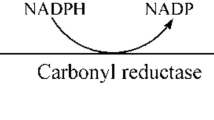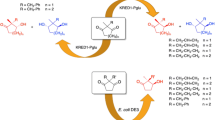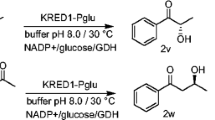Abstract
A novel nicotinamide adenine dinucleotide phosphate-dependent carbonyl reductase, 3-quinuclidinone reductase, was isolated from Rhodotorula rubra JCM3782. The enzyme catalyzes the asymmetric reduction of 3-quinuclidinone to (R)-3-quinuclidinol. The gene encoding the enzyme was also cloned and sequenced. A 819-bp nucleotide fragment was confirmed to be the gene encoding the 3-quinuclidinone reductase by agreement of the internal amino acid sequences of the purified enzyme. The gene encodes a total of 272 amino acid residues, and the deduced amino acid sequence shows similarity to those of several short-chain dehydrogenase/reductase family proteins. An expression vector, pWKLQ, which contains the full length 3-quinuclidinone reductase gene was constructed. Using Escherichia coli cells coexpressing the 3-quinuclidinone reductase and glucose dehydrogenase (cofactor regeneration enzyme) genes, 618 mM 3-quinuclidinone was almost stiochiometrically converted to (R)-3-quinuclidinol with an >99.9% enantiomeric excess within 21 h of reaction.



Similar content being viewed by others
References
Alabaster VA (1997) Discovery & development of selective M3 antagonists for clinical use. Life Sci 60:1053–1060
Bietti G, Doods HN, Cereda E, Schiavone A, Donetti A, Giovanni B (1990) New R(–)3-quinuclidinol derivatives. EP 404737
Bossard P (1997) Verfohren zur gewinnung von (R)-3-chinuclidinol durch racematspaltung von (R,S)-3-chinuclidinol. DE 197 15 465
Brieden W (1998) Process for the preparation of optically active 3-quinuclidinol. US Patent 5,744,606
Cross PE, Stobie A (1993) Quinuclidine esters process and intermediate for their preparation and pharmaceutical compositions containing them. WO 9306098
Don RH, Cox PT, Wainwright BJ, Baker K, Mattick JS (1991) ‘Touchdown’ PCR to circumvent spurious priming during gene amplification. Nucleic Acids Res 19:4008
Dräger B (2006) Tropinone reductases, enzymes at the branch point of tropane alkaloid metabolism. Phytochemistry 67:327–337
Goldberg K, Schroer K, Lütz S, Liese A (2007) Biocatalytic ketone reduction—a powerful tool for the production of chiral alcohols—part II: whole-cell reductions. Appl Microbiol Biotechnol 76:249–255
Gröger H, Chamouleau F, Orologas N, Rollmann C, Drauz K, Hummel W, Weckbecker A, May O (2006) Enantioselective reduction of ketones with “designer cells” at high substrate concentrations: highly efficient access to functionalized optically active alcohols. Angew Chem Int Ed 45:5677–5681
Hashimoto T, Nakajima K, Ongena G, Yamada Y (1992) Two tropinone reductases with distinct stereospecificities from cultured roots of Hyoscyamus niger. Plant Physiol 100:836–845
Ishihara T, Kakuta H, Moritani H, Utagawa T, Yanagisawa I (2004) Synthesis and biological evaluation of quinuclidine derivatives incorporating phenothiazine moieties as squalene. Chem Pharm Bull 52:1204–1209
Kataoka M, Shimizu S, Yamada Y (1990) Novel enzymatic production of d-(–)-pantoyl lactone through the stereospecific reduction of ketopantoic acid. Agric Biol Chem 54:177–182
Kataoka M, Rohani LPS, Yamamoto K, Wada M, Kawabata H, Kita K, Yanase H, Shimizu S (1997) Enzymatic production of ethyl (R)-4-chloro-3-hydroxybutanoate: asymmetric reduction of ethyl 4-chloro-3-oxobutanoate by an Escherichia coli transformant expressing the aldehyde reductase gene from yeast. Appl Microbiol Biotechnol 48:699–703
Kataoka M, Yamamoto K, Kawabata H, Wada M, Kita K, Yanase H, Shimizu S (1999) Stereoselective reduction of ethyl 4-chloro-3-oxobutanoate by Escherichia coli transformant cells coexpressing the aldehyde reductase and glucose dehydrogenase genes. Appl Microbiol Biotechnol 51:486–490
Kataoka M, Honda K, Shimizu S (2000) 3,4-Dihydrocoumarin hydrolase with haloperoxidase activity from Acinetobacter calcoaceticus F46. Eur J Biochem 267:3–10
Kataoka M, Kita K, Wada M, Yasohara Y, Hasegawa J, Shimizu S (2003) Novel bioreduction system for the production of chiral alcohols. Appl Microbiol Biotechnol 62:437–445
Leusch A, Tröger W, Greischel A, Roth W (2000) Pharmacokinetics of the M1-agonist talsaclidine in mouse, rat, rabbit and monkey, and extrapolation to man. Xenobiotica 30:797–813
Matsuyama A, Hamatani T (1998) Processes for production of optical active quinuclidinol. EP 863212
Muchmore DC (1993) Enantiomeric enrichment of (R,S)-quinuclidinol. US Patent 5,215,918
Nomoto F, Hirayama Y, Ikunaka M, Inoue T, Otsuka K (2003) A practical chemoenzymatic process to access (R)-quinuclidin-3-ol on scale. Tetrahedron: Asymmetry 14:1871–1877
Ochman H, Gerber AS, Hartl DL (1988) Genetic applications of an inverse polymerase chain reaction. Genetics 120:621–623
Portseffen A, Dräger B, Nahrstedt A (1994) The reduction of tropinone in Datura stramonium root cultures by two specific reductases. Phytochemistry 37:391–400
Rehavi M, Maayani S, Sokolovsky M (1977) Enzymatic resolution and cholinergic properties of (+/−) 3-quinuclidinol derivatives. Life Sci 21:1293–1302
Rzeszotarski WJ, McPherson DW, Ferkany JW, Kinnier WJ, Noronha-Blob L, Kirkien-Rzeszotarski A (1988) Affinity and selectivity of the optical isomers of 3-quinuclidinyl benzilate and related muscarinic antagonists. J Med Chem 31:1463–1467
Sanger F, Nicklen S, Coulson AR (1977) DNA sequencing with chain-terminating inhibitors. Proc Natl Acad Sci U S A 74:5463–5467
Sato E, Enomoto K (1999) Process for producing optically active 3-quinuclidinol derivatives. EP 945518
Shimizu S, Hattori S, Hata H, Yamada H (1988) A novel fungal enzyme, NADPH-dependent carbonyl reductase, showing high specificity to conjugated polyketones: purification and characterization. Eur J Biochem 174:37–44
Sternbach LH, Kaiser S (1952) Antispasmodics. I. Bicyclic basic alcohols. J Am Chem Soc 74:2215–2218
Takanaka M (2006) Process for producing optically active 3-quinuclidinols. US Patent 20060047122
Takeuchi M, Naito R, Hayakawa M, Okamoto Y, Yonetoku Y, Ikeda K, Isomura Y (1996) Novel quinuclidine derivatives and medical composition thereof. EP 0801067
Visser H, Vreugdenhil S, de Bont JAM, Verdoes JC (2000) Cloning and characterization of an epoxide hydrolase-encoding gene from Rhodotorula glutinis. Appl Microbiol Biotechnol 53:415–419
Ward JS, Merritt L, Calligaro DO, Bymaster FP, Shannon HE, Mitch CH, Whitesitt C, Brunsting D, Sheardown MJ, Olesen PH, Swedberg MDB, Jeppesen L, Sauerberg P (1998) 1,2,5-Thiadiazole analogs of aceclidine as potent M1 muscarinic agonists. J Med Chem 41:379–392
Yamamoto H, Matsuyama A, Kobayashi Y (2003a) Synthesis of ethyl (S)-4-chloro-3-hydroxybutanoate using fabG-homologues. Appl Microbiol Biotechnol 61:133–139
Yamamoto H, Ueda M, Ritsuzui P, Hamatani T (2003b) Methods for producing optical active alcohols. EP 1318200
Yamamoto H, Mitsuhashi K, Kimoto N, Matsuyama A, Esaki N, Kobayashi Y (2004) A novel NADH-dependent carbonyl reductase from Kluyveromyces aestuarii and comparison of NADH-regeneration system for the synthesis of ethyl (S)-4-chloro-3-hydroxybutanoate. Biosci Biotechnol Biochem 68:638–649
Yasohara Y, Kizaki N, Hasegawa J, Wada M, Kataoka M, Shimizu S (2000) Molecular cloning and overexpression of the gene encoding an NADPH-dependent carbonyl reductase from Candida magnoliae, involved in stereoselective reduction of ethyl 4-chloro-3-oxobutanoate. Biosci Biotechnol Biochem 64:1430–1436
Acknowledgments
This work was supported in part by a grant-in-aid for Developmental Research from the New Energy and Industrial Technology Development Organization (NEDO). This work was also supported in part by a grant-in-aid for Scientific Research, no. 20380051 (to MK), from the Japan Society for the Promotion of Science (JSPS), and by the Targeted Proteins Research Program (TPRP) of the Ministry of Education, Culture, Sports, Science and Technology (MEXT), Japan. The technical assistance of Ms. N. Kitamura and Mr. H. Saito of this laboratory is greatly appreciated.
Author information
Authors and Affiliations
Corresponding author
Rights and permissions
About this article
Cite this article
Uzura, A., Nomoto, F., Sakoda, A. et al. Stereoselective synthesis of (R)-3-quinuclidinol through asymmetric reduction of 3-quinuclidinone with 3-quinuclidinone reductase of Rhodotorula rubra . Appl Microbiol Biotechnol 83, 617–626 (2009). https://doi.org/10.1007/s00253-009-1902-2
Received:
Revised:
Accepted:
Published:
Issue Date:
DOI: https://doi.org/10.1007/s00253-009-1902-2




